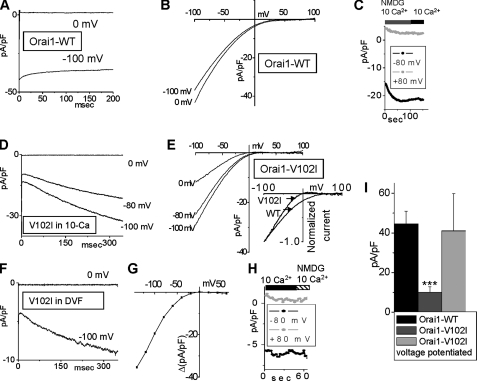FIGURE 6.
The Orai1V102I-CRAC channel is potentiated by negative voltages. A, Orai1WT-CRAC current did not increase at –100 mV, after equilibration in 10 mm Ca2+ and 0 mV holding potential. B, I/V values recorded immediately after the voltage steps shown in A. C, replacement of Na+ with NMDG+ did not affect the Orai1WT-CRAC current in 10 mm Ca2+. D, potentiation of the Orai1V102I -CRAC current during hyperpolarizing voltage steps, after equilibration in 10 mm Ca2+. E, I/V values were recorded immediately after the voltage steps in D. Inset, scaled I/Versus of Orai1V102I-CRAC and Orai1WT-CRAC for comparison. Orai1V102I-CRAC shows steeper voltage dependence then Orai1WT-CRAC. F, voltage potentiation of Orai1V102I-CRAC current in DVF. G, current difference between the beginning and the end of 350-ms voltage steps in 10 mm Ca2+ at different voltages is plotted versus voltage. The current was potentiated by potentials lower than 20 mV. H, replacement of Na+ with NMDG+ did not affect the Orai1V102I-CRAC current in 10 mm Ca2+, demonstrating preserved selectivity for Ca2+. I, maximal currents at –100 mV in 10 Ca2+ of Orai1WT-CRAC (n = 6), Orai1V102I-CRAC before (n = 9), and after voltage-dependent potentiation (n = 5).

